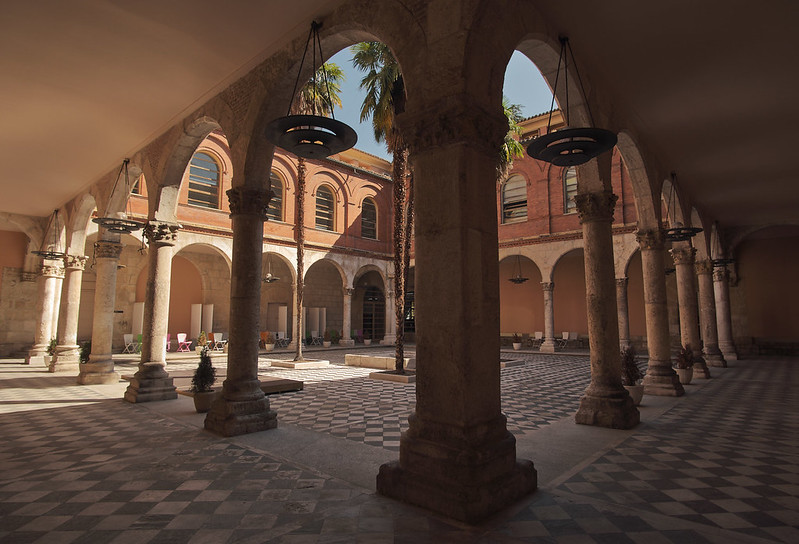There are many things to do in Valladolid, Spain, but this article will help you decide what to do while you’re in town. We’ll talk about museums like the Museo Nacional de Escultura, the Iglesia de San Pablo, and the Palacio Santa Cruz. Visiting these places will give you a great feel for the city, so we hope this article has helped you plan your trip!
Museo Nacional de Escultura
The National Museum of Sculpture is one of Spain’s oldest museums. It houses a collection of sculptures, mostly from the late Middle Ages to the early nineteenth century, along with fine paintings. It is the largest and most important Spanish collection of sculptural works in the Peninsula and arguably the best in Europe. The museum was founded in 1842, and for over half a century, it housed the works of artists from the former National Museum of Artistic Reproductions.
The collection of replicas includes obras from many different civilisations. The museum has replicas of estatuas from all time periods and different techniques, including yeso, terracotas, and mechanical imitators. The museum’s permanent exhibition includes several pieces of art by famous Spanish artists. There’s a wide selection of works on display here, but my favorite part is the Belen Napolitano, which is one of the museum’s most famous works.
Iglesia de San Pablo
The Iglesia de San Pablo in the city of Valladolid is one of Spain’s oldest cathedrals. This Roman Catholic cathedral dates back to the 14th century. Its Gothic decoration is impressive, with two torres and a single nave with open capillas. It was once the main church in Valladolid and was once the birthplace of Felipe IV. The church was desecrated during the French invasion of the nineteenth century, and its facilities were converted into a prison.
The conventual church of San Pablo is one of the most important buildings in the city. It sits on the plaza, which is an important gathering place. The building’s construction was commissioned by Fray Juan de Torquemada, who was a famous inquisitor. In 1468, he was tasked with obtaining papal bulas and was able to finish the construction of the church. Afterward, the Duque de Lerma initiated the reform of the convent, and the main facade was added.
Campo Grande
Campo Grande is a triangular public park located in the center of Valladolid, Spain. Its surface is over 115,000 square meters (11.5 acres), and is surrounded by the Paseo de los Filipinos, Acera de Recoletos, and Zorrilla. The park is enclosed by a fence with doors on all sides. It is a popular spot for locals and visitors alike.
There are many things to do in this park, which is the city’s largest. There are bronze statues and an aviary with pigeons, roosters, and pheasants. The park has a small library and a boatman who tells stories while he rows. This park is also a great place for a stroll in the early morning or late afternoon.
If you’re travelling by bus, it’s easy to find a route that meets your requirements and budget. There are several bus companies that offer service between Valladolid and Campo Grande. Moovit offers free maps and directions so you can get to your destination easily. You can also use the service of a taxi if you’re unsure of where to go. Its drivers will show you the way.
Palacio de Santa Cruz
The first Renaissance building in Spain was the Palacio de Santa Cruz. It was designed by Cardinal Diego de Saavedra and was commissioned by Philip IV in 1491. It originally housed two courts and a jail system, but now it’s the seat of Spain’s foreign ministry. While you’re there, you should take some time to see the interior, including the beautiful back garden.
Plaza Mayor de Valladolid
The Plaza Mayor de Valladolid is one of the largest public squares in Spain. Formerly a market, it was renamed Plaza Mayor after the XVI century. You can stroll around the plaza and enjoy the city’s attractions. Afterwards, you can enjoy the nightlife and shopping options. Here you can find some of Valladolid’s best restaurants. You can also have a nice coffee break in the plaza.
The plaza was originally made of ladrillo, but it was later replaced with a cement cap. In 1996, a restoration project was initiated to restore the plaza’s original color. The work was completed successfully, and the plaza now resembles its original look. It is a great example of Spanish architecture. The buildings surrounding the plaza are painted red. Despite the color, no building in the area is similar to the plaza.
The plaza is one of Valladolid’s most important places for visitors. It’s located in the heart of the city and is marked by the Conde Ansurez monument made of granitic stone. The plaza has a fascinating history. It’s also the location of many important events throughout the year, including the Valladolid Festival, the World Padel Tour, and the city’s annual market.
Academia de Caballeria
The liviendas, or stables, of the Academia de Caballeria Valldolid have their origins in the military culture of the city. The patronate of military houses built these buildings by using small blocks, creating an open structure. The remembrances of the Cavalry are on display at the museum. The cavalry museum also features several equestrian artifacts.
The first building of the academy was constructed in 1852. This was later moved to Valladolid, which was originally designated as a presidio. In 1843, construction on the new building began. The new building, designed by Adolfo Pierrad Perez, was dedicated on May 4, 1921. In the course of time, the equestrian artifacts were moved to several new locations.
The museum houses paintings, trophies, mantilsas, and photographs, as well as other artifacts. You can even view the original horseshoes. If you want to know more about the history of the academy, check out its website and contact its staff. They will answer any questions you may have. This museum is located at Paseo Zorrilla, 2 in Valladolid.
Museo Oriental
The Museo Oriental Valladolid is located in the heart of the city. Founded in 1980, the museum exhibits a variety of materials, art, and customs. Visitors will find pottery, esmaltes, and caligrafia, as well as clothing and furniture, among other items. The collection also includes works of art and armas. It has a strong connection to the Spanish culture, as Spain has a long history with Asia.
The museum’s collection spans several centuries, with pieces from China, Japan, and the Filipinas taking center stage. Visitors will see works of art made from bronze, porcelain, marfil, and caligraphy, as well as a variety of religious and indigenous groups. The museum is located in the former Real Colegio de Padres Agustinos, which was a school for Filipino missionaries.
The museum’s collections are the result of Spanish and Chinese missionary exploration for over four centuries. Located in a historic 1759 Augustinian Fathershe Royal College, the Museo Oriental is the place to go to learn more about the culture of the East. During your stay, you can visit the museum and see the collection of art and find out what to do in the area. The museum is open Monday through Sunday.
Mercado Del Val
If you want an authentic market experience, make sure you check out the Mercado Municipal. The city is famous for its cheap clothing and taquerias, and you can even sample some delicious local fare. Located on the eastern side of the market, you can also find fresh flowers. This bustling market is packed with people and is an excellent way to experience the local way of life.
The market was first built in the 19th century and was inspired by the famous Les Halles in Paris. However, it underwent a recent renovation in 1982 in honor of Val’s centennial. While the interior is still well-preserved, it could use a bit of a facelift. If you’re looking for something to do in Valladolid, this is a great option.
If you’re looking for a place to eat in Valladolid, don’t miss the Mercado Municipal. Open in the morning until 1pm, it’s packed with everything you need for a tasty lunch. The market is divided into several sections, so you can sample everything from fresh fruit to homemade tortillas. While you’re in the city center, be sure to check out the Cathedral of Valladolid.

